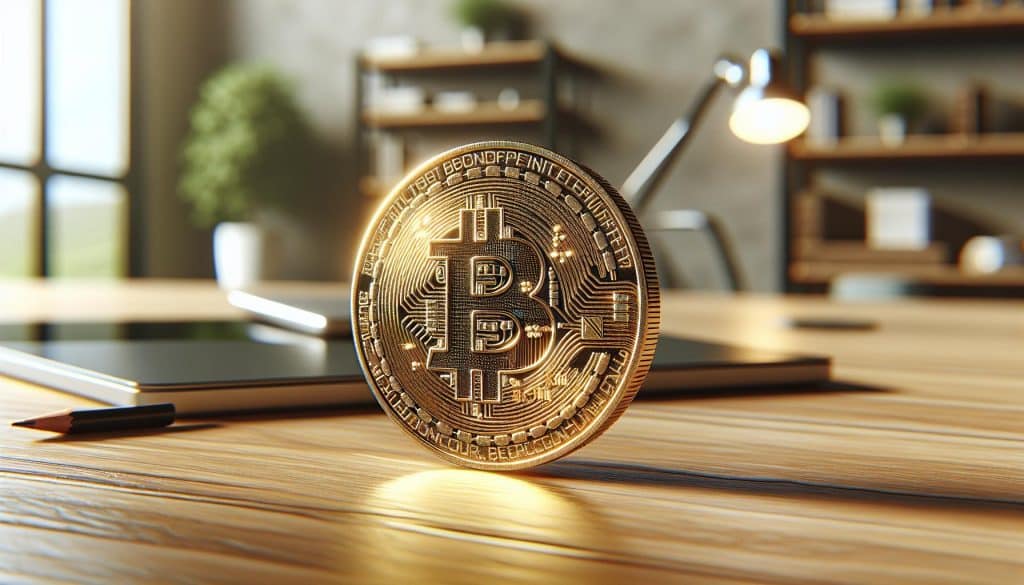Key Takeaways
- Physical Bitcoins are tangible representations of cryptocurrency that typically contain a tamper-evident hologram concealing a private key linked to actual Bitcoin on the blockchain.
- The first widely recognized physical Bitcoins were Casascius coins created by Mike Caldwell in 2011, with production halted in 2013 due to regulatory concerns from FinCEN.
- These coins serve multiple purposes beyond cryptocurrency value, functioning as collectibles, educational tools, gifts, and conversation pieces that bridge traditional and digital currency concepts.
- Physical Bitcoin offers unique security benefits through “cold storage” that protects assets from online threats, while also providing investment potential as rare collectibles with historical significance.
- Owners face distinct risks including physical theft, environmental damage, counterfeit products, and verification challenges that don’t affect purely digital cryptocurrency.
- The legal status of physical Bitcoin varies globally, with regulatory classifications creating challenges for manufacturers who now often ship coins without preloaded cryptocurrency value.
While Bitcoin exists primarily in the digital realm, physical Bitcoins have emerged as fascinating collectibles and tangible representations of cryptocurrency value. These metal coins, typically made of brass or precious metals, contain a tamper-evident hologram hiding a private key that controls actual Bitcoin on the blockchain.
You might wonder why anyone would want to transform digital currency into a physical object. Beyond their aesthetic appeal, physical Bitcoins serve as conversation starters, educational tools, and unique gifts for crypto enthusiasts. They bridge the conceptual gap between traditional currency and digital assets, making cryptocurrency more accessible to those unfamiliar with blockchain technology.
What Is Physical Bitcoin?
Physical bitcoins are tangible representations of digital cryptocurrency that combine artistic design with actual Bitcoin value. Unlike purely digital Bitcoin that exists only on the blockchain, physical bitcoins are metal coins (typically brass, silver, gold, or titanium) featuring a tamper-evident hologram sticker that conceals a private key linked to Bitcoin funds.
The concept originated with Casascius coins in 2011, created by Mike Caldwell who produced thousands of these collectible items before discontinuing due to regulatory concerns. Each authentic physical Bitcoin contains a predetermined amount of cryptocurrency that can be redeemed by peeling the hologram to reveal the private key underneath.
Physical bitcoins serve multiple purposes beyond their cryptocurrency value:
- Collectible items: Many collectors value them for their craftsmanship and historical significance
- Educational tools: They help introduce the concept of cryptocurrency to newcomers
- Gifts: They make unique presents for crypto enthusiasts
- Conversation pieces: They bridge the gap between traditional and digital currency
Unlike Bitcoin ATMs (such as those operated by Cash2Bitcoin or Bitcoin Depot) that allow you to convert cash to digital currency, physical bitcoins aren’t meant for daily transactions. They’re designed to store value long-term while providing a tangible representation of cryptocurrency.
It’s important to distinguish legitimate physical bitcoins from Bitcoin scams that might use similar physical tokens without actual cryptocurrency backing. Authentic physical bitcoins come from reputable manufacturers and include security features to verify their legitimacy and prevent counterfeiting.
The rarity of certain physical bitcoin collections has created a specialized market where some coins sell for significantly more than their face value, similar to how the famous Bitcoin pizza purchase (where 10,000 BTC bought two pizzas in 2010) has become a valuable piece of cryptocurrency history.
The History of Physical Bitcoin
Physical Bitcoin’s history traces the evolution from intangible digital assets to collectible metal tokens that bridge traditional and cryptocurrency worlds. This transformation represents one of cryptocurrency’s most interesting tangible manifestations.
From Digital to Tangible: Early Development
Physical Bitcoin emerged in 2011 as cryptocurrency enthusiasts sought ways to make the abstract concept of Bitcoin more accessible. Mike Caldwell created the first widely recognized physical Bitcoins, called Casascius coins, minting the initial batch in September 2011. These brass tokens featured a holographic seal protecting a private key linked to actual Bitcoin on the blockchain.
The early physical Bitcoin development coincided with Bitcoin’s struggling legitimacy phase, when a single BTC was worth just $6-$10. During this period, physical representations helped validate cryptocurrency as something with tangible value. Early adopters often used these physical tokens as conversation starters at tech meetups and cryptocurrency conferences.
By 2013, the concept had gained traction with multiple manufacturers entering the market, each developing unique designs and security features. The U.S. Financial Crimes Enforcement Network eventually classified the production of funded physical Bitcoins as money transmission, forcing several early creators, including Caldwell, to stop selling pre-loaded coins.
Notable Physical Bitcoin Manufacturers
Several prominent manufacturers have shaped the physical Bitcoin landscape over the years:
Casascius Coins – Created by Mike Caldwell from 2011-2013, these are the most famous physical Bitcoins. Caldwell produced approximately 27,500 coins in denominations ranging from 0.1 to 1,000 BTC before ceasing operations due to regulatory concerns. Today, unredeemed Casascius coins command significant premiums among collectors.
Denarium Bitcoin – Founded in Finland in 2015, Denarium produced both funded and unfunded physical Bitcoins with elegant designs until ceasing operations in 2020. Their coins featured gold and silver plating with sophisticated security elements.
Titan Bitcoin – Launched in 2013, this company specialized in high-end precious metal coins, including gold and titanium editions. Their limited production runs featured detailed craftsmanship and advanced security features.
BTCC Mint – Started by one of China’s earliest Bitcoin exchanges, BTCC Mint produced collectible series from 2016-2018 that commemorated significant moments in Bitcoin history, including the famous Bitcoin pizza transaction of 2010 when 10,000 BTC were spent on two pizzas.
Opendime – Taking a different approach, Opendime created USB stick “physical Bitcoins” that functioned as bearer instruments anyone could verify without accessing the private key. These devices bridged the gap between physical tokens and digital wallets.
The manufacturing landscape changed dramatically after 2017 as regulatory scrutiny increased. Most modern physical Bitcoin products now ship without preloaded value to avoid money transmission laws, functioning instead as collectibles or do-it-yourself storage solutions.
Types of Physical Bitcoin
Physical Bitcoin products come in several distinct forms, each serving different purposes for cryptocurrency enthusiasts and collectors. These tangible representations of digital currency vary in functionality, design, and intended use cases.
Cold Storage Coins
Cold storage coins function as offline cryptocurrency wallets in physical form. These coins contain a private key hidden beneath a tamper-evident hologram or seal, allowing you to store Bitcoin securely away from internet-connected devices. Manufacturers like Denarium and BTCC Mint produce cold storage options with high-quality security features such as tamper-evident holograms and encrypted QR codes. These physical wallets protect your cryptocurrency from online threats like hacking or malware by keeping the private key completely offline until you’re ready to access the funds. Bitcoin Depot and similar companies sometimes offer cold storage solutions as alternatives to their digital wallet services.
Commemorative Collectibles
Commemorative Bitcoin coins celebrate significant events or milestones in cryptocurrency history. Unlike functional storage devices, these collectibles typically don’t contain actual Bitcoin value but commemorate important moments like the Bitcoin Pizza Day (when 10,000 BTC was spent on two pizzas in 2010). These items feature intricate designs, limited mintage numbers, and often come with certificates of authenticity. Collectors value these pieces for their artistic merit and historical significance rather than their utility as cryptocurrency storage. Some commemorative coins mark Bitcoin halving events, price milestones, or honor influential figures in the cryptocurrency community.
Loaded Bearer Instruments
Loaded bearer instruments represent physical Bitcoin products that contain actual cryptocurrency value accessible to whoever possesses the physical object. The original Casascius coins exemplify this category as they came pre-loaded with specific Bitcoin amounts (1 BTC, 5 BTC, etc.) and functioned as bearer instruments—whoever possessed the coin and revealed the private key could claim the associated cryptocurrency. Due to regulatory concerns, few companies still offer pre-loaded coins. This category carries risks similar to cash—if lost or stolen, the value is accessible to whoever finds it. Consumers should exercise caution as this area has attracted Bitcoin scams where fraudulent products claim to contain cryptocurrency but actually don’t. Cash2Bitcoin Bitcoin ATM networks sometimes educate customers about these risks when they’re considering physical Bitcoin options.
How Physical Bitcoin Works
Physical Bitcoin combines tangible elements with cryptocurrency’s digital structure. These coins function as both collectibles and potential stores of value through specialized security measures and redemption processes.
Security Features and Authenticity Verification
Physical Bitcoin manufacturers implement multiple security features to protect the enclosed value and verify authenticity. The tamper-evident hologram serves as the primary security mechanism, showing clear signs of interference if anyone attempts to access the private key underneath. Legitimate coins often include microprinting, unique serial numbers, and specialized materials that resist counterfeiting efforts. Manufacturers like Casascius and Denarium integrate these features with custom-designed holograms that display distinct patterns when viewed under ultraviolet light.
When examining a physical Bitcoin, you’ll notice authenticity markers like QR codes that link to blockchain verification services. These allow you to confirm the coin’s associated Bitcoin address still contains the specified value without compromising the private key. The Bitcoin Depot and other trustworthy distributors maintain verification databases where you can check serial numbers against manufacturer records, protecting you from potential Bitcoin scams that have emerged in the collectible market.
Redeeming the Digital Value
Redeeming the value from a physical Bitcoin involves a straightforward but irreversible process. You’ll need to carefully remove the tamper-evident hologram to reveal the private key underneath—this action permanently alters the coin’s appearance and typically reduces its collectible value. Once exposed, the private key must be imported into a Bitcoin wallet through a “sweeping” process that transfers the associated cryptocurrency to your personal wallet.
This redemption system operates similarly to how early Bitcoin transactions worked during the famous Bitcoin pizza purchase of 2010, where digital value transfers directly from one party to another without intermediaries. The entire redemption process requires no identification or third-party approval, functioning as a bearer instrument where possession equals ownership. Unlike services like Cash2Bitcoin Bitcoin ATMs that require verification procedures, physical Bitcoin redemption happens entirely between you and the blockchain, maintaining the cryptocurrency’s principle of financial autonomy while adding a tangible component to digital value.
Benefits of Owning Physical Bitcoin
Physical Bitcoin offers unique advantages that purely digital cryptocurrency can’t match. These tangible representations combine the innovative technology of blockchain with the familiarity of physical assets, creating several distinct benefits for owners.
Tangible Asset Protection
Physical Bitcoin provides a concrete form of security that’s fundamentally different from digital wallets. Your cryptocurrency becomes immune to online hacking attempts when stored offline in a physical coin. This “cold storage” method disconnects your assets from internet vulnerability, protecting your investment from malware, phishing attacks, and exchange hacks.
The tactile nature of physical Bitcoin also offers psychological security. You’re holding your wealth in your hands rather than trusting it to digital systems you can’t see. This tangible element creates peace of mind, especially during volatile market periods or internet outages when digital access might be compromised.
Unlike hot wallets that remain potentially vulnerable to sophisticated cyber attacks, physical Bitcoin creates an air-gapped security layer that hackers simply can’t breach remotely. This protection extends to electricity and infrastructure dependencies—your assets remain accessible even during power outages or internet disruptions.
Collector Appeal and Investment Potential
Physical Bitcoin coins have developed significant collector value beyond their cryptocurrency content. Limited-edition releases from manufacturers like Casascius have appreciated dramatically, sometimes selling for 5-10 times their face value. The famous Casascius 1,000 BTC gold coin exemplifies this phenomenon, with collectors valuing it well beyond its cryptocurrency content.
The collectible market follows similar patterns to rare numismatics—limited mintages, historical significance, and unique designs drive value. Early physical Bitcoin pieces, particularly from discontinued series, have established themselves as cryptocurrency artifacts. This historical significance creates a fascinating parallel to the legendary bitcoin pizza transaction, where both represent pivotal moments in Bitcoin’s evolution from abstract concept to valuable asset.
Investment potential increases with:
- Provenance verification from reputable sources
- Tamper-evident features intact
- Original packaging and documentation
- Limited edition status
- Historical significance in the cryptocurrency timeline
Unlike digital Bitcoin, which remains identical regardless of age or history, physical Bitcoin coins develop unique stories and provenance that collectors value. Established bitcoin depot services and physical bitcoin retailers now recognize this dual-value proposition, offering authentication services alongside their products to verify legitimacy and protect buyers from bitcoin scams in the collectibles market.
Risks and Considerations
Physical Bitcoin ownership comes with unique challenges that differ from purely digital cryptocurrency holdings. Understanding these risks is essential before investing in or collecting these tangible representations of digital value.
Security Vulnerabilities
Physical Bitcoin products face several security vulnerabilities that don’t affect their digital counterparts. The private key hidden under the hologram becomes exposed once redeemed, creating a permanent security compromise. Anyone who observes the key during the redemption process could potentially steal the funds. Physical coins are susceptible to theft or loss in the same way as cash—if someone takes your physical Bitcoin or you misplace it, the value is likely gone forever with no recovery mechanism.
Environmental factors pose additional threats to physical Bitcoin. Water damage, fire, or extreme temperatures can destroy the hologram or printed private key, making fund recovery impossible. Unlike digital Bitcoin protected by encryption, physical representations require secure physical storage similar to valuable jewelry or important documents. Some collectors use fireproof safes or safety deposit boxes to mitigate these risks.
Bitcoin scams have increasingly targeted the physical Bitcoin market, with counterfeiters creating convincing replicas that contain no actual cryptocurrency value. These fake coins often lack the sophisticated security features of legitimate products but can fool inexperienced buyers.
Verification Challenges
Verifying the authenticity and value of physical Bitcoin presents unique challenges. Unlike digital transactions that can be instantly confirmed on the blockchain, physical Bitcoin requires trust in the manufacturer’s security features. Many collectors struggle to differentiate between genuine products from reputable manufacturers and sophisticated counterfeits in the secondary market.
The loaded value of a physical Bitcoin can’t be verified without compromising the coin’s security seal. Buyers must trust that the advertised amount of Bitcoin remains associated with the embedded private key and hasn’t been secretly redeemed. This verification gap creates opportunities for fraud where sellers might pass off empty coins as loaded ones.
Some verification services exist through established entities like bitcoin depot locations, which offer authentication services for physical cryptocurrency. However, these services typically require breaking the tamper-evident seal, destroying the coin’s original condition and potentially its collectible value.
For collectors seeking specific items with historical significance—such as early Casascius coins or commemorative editions celebrating events like the famous bitcoin pizza transaction—provenance verification becomes additionally complex. Documentation of a coin’s history and chain of ownership adds another layer of authentication challenges beyond simply confirming the associated cryptocurrency value.
When purchasing physical Bitcoin through unconventional channels rather than directly from manufacturers, you’re exposed to counterparty risk. Unlike using a cash2bitcoin bitcoin ATM for digital purchases, physical transactions typically offer no recourse if the seller disappears after receiving payment for counterfeit goods.
The Legal Status of Physical Bitcoin
Physical Bitcoin exists in a complex legal landscape that varies significantly across jurisdictions worldwide. Since these tangible representations contain actual cryptocurrency value, they’re subject to regulations that differ from both traditional currency and purely digital assets.
Regulatory Classification Challenges
Physical Bitcoins occupy a unique regulatory position, blending characteristics of both collectibles and financial instruments. In the United States, the Financial Crimes Enforcement Network (FinCEN) classifies businesses that produce loaded physical Bitcoins as money transmitters. This classification led Mike Caldwell’s Casascius operation to cease pre-loading coins with Bitcoin value in 2013. Following this precedent, many physical Bitcoin manufacturers now ship their products without cryptocurrency value, allowing buyers to load them privately.
Regional Variations in Legality
The legal status of physical Bitcoin varies dramatically by country:
- United States: Physical Bitcoin is legal to own but manufacturing pre-loaded coins requires money transmitter licensing.
- European Union: Generally permissive toward physical Bitcoin as collectibles, though recent anti-money laundering directives may affect their use as bearer instruments.
- China: Maintains strict prohibitions against cryptocurrency trading, making physical Bitcoin’s legal status uncertain.
- Japan: Recognizes Bitcoin as legal property, with physical representations typically falling under collectible regulations.
Tax Implications
Physical Bitcoin carries significant tax considerations. In most jurisdictions, including the United States, they’re subject to:
- Capital gains tax when the enclosed Bitcoin appreciates in value
- Collectible taxes when rare coins sell above their cryptocurrency value
- Import duties when purchasing across international borders
The IRS specifically views physical Bitcoin as property for tax purposes, requiring owners to track basis points and report gains accordingly.
Legal Risks for Owners
Owning physical Bitcoin involves several legal considerations. Possession may trigger reporting requirements in jurisdictions with strict anti-money laundering provisions. When using services like bitcoin depot locations or cash2bitcoin Bitcoin ATMs to convert physical Bitcoin, you’re subject to the same Know Your Customer (KYC) requirements as digital transactions.
Anti-Counterfeiting Measures
Many jurisdictions apply traditional anti-counterfeiting laws to physical Bitcoin. Creating fake versions of established products like Casascius coins potentially violates both counterfeiting statutes and intellectual property laws. The rise of bitcoin scams involving counterfeit physical coins has prompted increased scrutiny from consumer protection agencies in several countries.
Bearer Instrument Regulations
Physical Bitcoins with embedded value function similarly to bearer instruments like cash or bearer bonds. In many jurisdictions, financial regulations limit the transportation or transmission of high-value bearer instruments across borders without declaration. The infamous bitcoin pizza purchase that established Bitcoin’s first real-world value transaction wouldn’t face the same regulatory scrutiny as today’s physical Bitcoin transfers.
The Future of Physical Bitcoin
Physical Bitcoin stands at a crossroads of innovation and adaptation. As cryptocurrency continues its mainstream journey, tangible representations evolve to meet changing market demands and regulatory landscapes.
Technological Innovations
Physical Bitcoin manufacturers are incorporating advanced security features beyond traditional holograms. New coins integrate NFC chips allowing verification without compromising the private key. Some designs now include biometric authentication, requiring fingerprint verification to access stored value. These innovations address previous security vulnerabilities while maintaining the tactile appeal that makes physical Bitcoin unique.
Market Evolution and Mainstream Adoption
Physical Bitcoin’s market is expanding beyond collector circles. Bitcoin depot locations increasingly offer authenticated physical coins alongside their ATM services, providing convenient access points for newcomers. This retail presence helps bridge the knowledge gap for those unfamiliar with digital wallets but interested in cryptocurrency ownership.
Similar to how the famous bitcoin pizza purchase represented early adoption, physical coins serve as entry points for cryptocurrency newcomers. Their tangible nature makes complex blockchain concepts more approachable and provides a familiar medium for those accustomed to traditional currency.
Regulatory Adaptations
Manufacturers are developing creative solutions to navigate evolving regulations. Many have shifted to a “load-your-own” model where coins ship without preloaded value, avoiding money transmitter classifications while maintaining collectibility. Others partner with licensed financial institutions to create compliant products that satisfy both regulatory requirements and consumer demand.
Protection Against Scams
The physical Bitcoin industry is implementing standardized authentication protocols to combat bitcoin scams. Verification databases now track serial numbers and ownership histories, allowing buyers to confirm authenticity before purchase. Education initiatives highlight common counterfeit tactics, empowering collectors to identify suspicious offerings in secondary markets.
Environmental Considerations
Sustainability concerns are driving innovation in physical Bitcoin production. Manufacturers are exploring recycled materials and carbon-neutral manufacturing processes. Some companies now offer biodegradable packaging or carbon offset programs to address environmental impacts while maintaining the premium quality collectors expect.
Collectible Status and Investment Potential
The rarity of early physical Bitcoin continues to drive collector interest. Limited-edition coins from notable moments in cryptocurrency history have appreciated substantially, with some Casascius coins selling for 50 times their face value. This collectible status creates a dual investment opportunity—both in the underlying cryptocurrency and in the artifact itself.
As physical Bitcoin evolves, it retains its unique position at the intersection of digital finance and tangible assets, continuing to serve as a bridge between traditional concepts of money and cryptocurrency’s digital future.
Conclusion
Physical Bitcoin represents a fascinating intersection of traditional collectibles and digital currency innovation. By holding actual Bitcoin value in tangible form these metal tokens serve as both functional cold storage and valuable collectibles with their own investment potential.
As you consider adding physical Bitcoin to your collection be mindful of security concerns verification challenges and the evolving regulatory landscape. The market continues to adapt with enhanced security features standardized authentication and eco-friendly approaches.
Whether you’re drawn to their aesthetic appeal educational value or investment potential physical Bitcoins offer a unique way to participate in cryptocurrency culture. They bridge the gap between digital finance and tangible assets making Bitcoin accessible to those who appreciate the reassurance of holding something real.
Frequently Asked Questions
What are physical Bitcoins?
Physical Bitcoins are tangible coins made from materials like brass or precious metals that represent cryptocurrency value. They feature a tamper-evident hologram concealing a private key linked to actual Bitcoin on the blockchain. Unlike purely digital Bitcoin, these collectible items give cryptocurrency a physical form while maintaining their digital value.
How do physical Bitcoins work?
Physical Bitcoins contain a private key hidden beneath a tamper-evident hologram. To access the Bitcoin value, the owner must carefully remove the hologram and import the key into a digital wallet. The coins include security features like microprinting and unique serial numbers that verify authenticity and protect the enclosed value.
Who created the first physical Bitcoins?
Mike Caldwell created the first widely recognized physical Bitcoins, called Casascius coins, in 2011. He produced thousands of these collectibles before discontinuing them due to regulatory concerns. These original coins have become highly sought-after collectibles in the cryptocurrency community.
What types of physical Bitcoin products exist?
There are three main types: cold storage coins (function as offline wallets), commemorative collectibles (celebrate crypto events but contain no actual value), and loaded bearer instruments (contain real cryptocurrency value like the original Casascius coins). Each serves different purposes for enthusiasts and collectors.
What are the benefits of owning physical Bitcoin?
Physical Bitcoins provide “cold storage” security against online hacking, offer a tangible representation of digital assets, and have collectible appeal. Limited-edition releases often appreciate significantly in value—sometimes 5-10 times their face value. They also serve as conversation starters and educational tools for cryptocurrency newcomers.
What risks are associated with physical Bitcoin?
Risks include security vulnerabilities during redemption, susceptibility to environmental damage (water/fire), and potential counterfeit coins in the market. Verification challenges exist when purchasing from secondary markets, and redemption permanently exposes the private key. Physical Bitcoins can also be lost or stolen like cash.
Are physical Bitcoins legal?
The legality varies by jurisdiction. In the US, ownership is legal, but manufacturing loaded coins requires licensing as money transmitters. The EU is generally permissive, while countries like China prohibit them. Physical Bitcoins are subject to capital gains and collectible taxes, with the IRS treating them as property.
How do I verify a physical Bitcoin’s authenticity?
Authentic physical Bitcoins come from reputable manufacturers and include security features like tamper-evident holograms, microprinting, and unique serial numbers. Many have QR codes linking to blockchain verification services. Established bitcoin depot services now offer authentication to protect buyers from scams in the collectibles market.
Can I redeem the Bitcoin value from a physical coin?
Yes, you can redeem the Bitcoin value by carefully removing the hologram to reveal the private key, then importing it into a Bitcoin wallet. However, this process is irreversible and eliminates the collectible premium value of the coin, as the security features will be compromised.
What’s the future of physical Bitcoin?
Physical Bitcoin is evolving with advanced security features like NFC chips and biometric authentication. Many manufacturers now use a “load-your-own” model to navigate regulations. Standardized authentication protocols are being developed to combat scams, and environmental sustainability is becoming a focus with recycled materials and carbon-neutral processes.
























 Bitcoin
Bitcoin  Ethereum
Ethereum  Tether
Tether  XRP
XRP  USDC
USDC  Lido Staked Ether
Lido Staked Ether  TRON
TRON  Dogecoin
Dogecoin  Cardano
Cardano  Figure Heloc
Figure Heloc  WhiteBIT Coin
WhiteBIT Coin  Wrapped stETH
Wrapped stETH  Bitcoin Cash
Bitcoin Cash  Wrapped Bitcoin
Wrapped Bitcoin  USDS
USDS  Chainlink
Chainlink  Wrapped eETH
Wrapped eETH  Binance Bridged USDT (BNB Smart Chain)
Binance Bridged USDT (BNB Smart Chain)  LEO Token
LEO Token  WETH
WETH  Hyperliquid
Hyperliquid  Monero
Monero  Stellar
Stellar  Zcash
Zcash  Coinbase Wrapped BTC
Coinbase Wrapped BTC  Ethena USDe
Ethena USDe  Litecoin
Litecoin  Sui
Sui  Avalanche
Avalanche  Hedera
Hedera  Shiba Inu
Shiba Inu  sUSDS
sUSDS  USDT0
USDT0  Dai
Dai  Mantle
Mantle  PayPal USD
PayPal USD  Toncoin
Toncoin  World Liberty Financial
World Liberty Financial  Cronos
Cronos  Ethena Staked USDe
Ethena Staked USDe  Uniswap
Uniswap  Polkadot
Polkadot  Aave
Aave  MemeCore
MemeCore  USD1
USD1  Bittensor
Bittensor  Rain
Rain  Canton
Canton